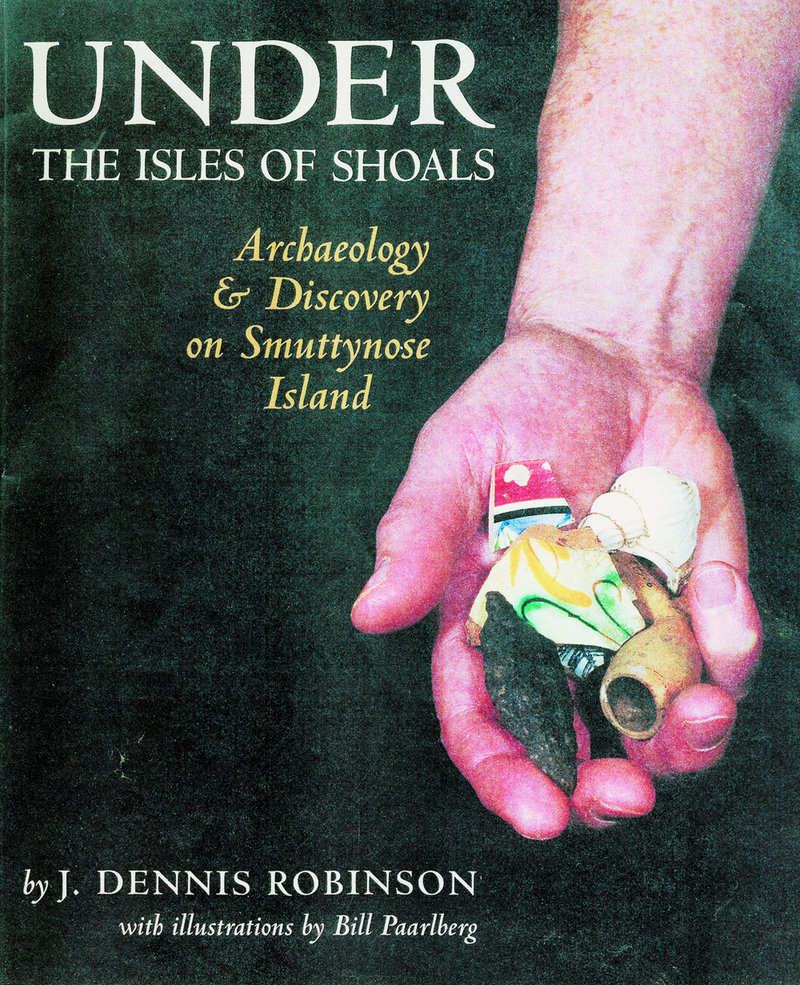“Under the Isles of Shoals: Archaeology & Discovery On Smuttynose Island” by well-known Piscataqua region writer J. Dennis Robinson might sound lofty and site-specific to the student and casual reader.
It does indeed focus on one of the earliest spots inhabited by Europeans (the Maine-New Hampshire boundary weaves between the isles), and the little outriders were used by Native Americans for thousands of years prior.
However, the new volume proves the perfect bridge between practical archaeology (the scientific study of objects found at various stratigraphical levels) and accurate popular history.
As a longtime historian and reviewer, I have seen the need for a book of this type and clarity. Charts showing layers or levels of occupation or potsherds from various periods have always left me cold, and often doubtful.
“Under the Isles of Shoals” provides a bridge between disciplines while presenting a delightful account of our southern sea boundary through time.
Robinson — an historian, journalist and “steward of Smuttynose Island” — is able to employ his fine writing with the best of the ongoing record of digs and assessments. He relies heavily on University of Southern Maine/Muskie School of Public Service archaeologist Nathan D. Hamilton and the latter predecessors of the isles, including professor Faith Harrington.
The book begins by asking “What is Archaeology?” and we are presented with film practitioners, including Indiana Jones and Laura Croft. In fact, the line from the 1932 movie “The Mummy” sets the stage: “Method is everything in archaeology, my boy.”
What could be more appropriate? For while admitting the taking of great pleasure in such adventure flicks, this observer has always winced when our action “film archaeologists” pulverize an ancient terrazzo floor or tip over a tomb in search of gold, jewels or even the Ark. The keys to the treasure are almost always the real treasure.
The facts lead to a picture honed from a combination of objects and documents. All digs ask of a location: Who was here? What was their life and culture like? How did it evolve and connect with other cultures through the years?
What makes “Under The Isles of Shoals” such a pertinent and pleasing book is that it is written for a general audience. One is informed but never talked down to.
It is well deigned and filled with historic photographs, contemporary color images and wonderful historically recreated drawings by Bill Paarlberg of Kittery Point.
Divided into eight chapters, the book discusses Smuttynose, the prehistoric hunting ground, the colonial fishing station, life on a rock, the Haley family occupation, the Thaxter family and the hotel era, and the place today.
Also included are wonderful appendices focused on recent digs, the Shoals Marine Lab, the Star Island Center, a bibliography and a great deal more. What one is left with is a lucid view of life on Smuttynose, in the context of the Piscataqua and New England.
As a historian, I have previously learned much about the Thaxter family. The archaeology concerning this era (1830s to the dawn of the 20th century) adds to their saga in an honest, unsentimental manner. Method is everything in archaeology.
William David Barry is a local historian who has authored/co-authored seven books, including “Maine: The Wilder Side of New England” and “Deering: A Social and Architectural History.” He lives in Portland.
Copy the Story Link
Send questions/comments to the editors.



Success. Please wait for the page to reload. If the page does not reload within 5 seconds, please refresh the page.
Enter your email and password to access comments.
Hi, to comment on stories you must . This profile is in addition to your subscription and website login.
Already have a commenting profile? .
Invalid username/password.
Please check your email to confirm and complete your registration.
Only subscribers are eligible to post comments. Please subscribe or login first for digital access. Here’s why.
Use the form below to reset your password. When you've submitted your account email, we will send an email with a reset code.